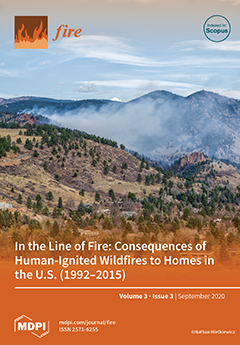Open AccessArticle
Recent Crown Thinning in a Boreal Black Spruce Forest Does Not Reduce Spread Rate nor Total Fuel Consumption: Results from an Experimental Crown Fire in Alberta, Canada
by
Dan K. Thompson, Dave Schroeder, Sophie L. Wilkinson, Quinn Barber, Greg Baxter, Hilary Cameron, Rex Hsieh, Ginny Marshall, Brett Moore, Razim Refai, Chris Rodell, Tom Schiks, Gregory J. Verkaik and Jessica Zerb
Cited by 24 | Viewed by 5520
Abstract
A 3.6 ha experimental fire was conducted in a black spruce peatland forest that had undergone thinning the year prior. After 50 m of spread in a natural stand at 35–60 m min
−1, the crown fire (43,000 kW m
−1 intensity
[...] Read more.
A 3.6 ha experimental fire was conducted in a black spruce peatland forest that had undergone thinning the year prior. After 50 m of spread in a natural stand at 35–60 m min
−1, the crown fire (43,000 kW m
−1 intensity using Byram’s method) encountered the 50% stem removal treatment; spread rates in the treatment were 50–60 m min
−1. Fuel consumption in the control (2.75 kg m
−2) was comparable to the treatment (2.35 kg m
−2). Proxy measurements of fire intensity using in-stand heat flux sensors as well as photogrammetric flame heights had detected intensity reductions to 30–40% of the control. Crown fuel load reductions (compensated by higher surface fuel load) appear to be the most significant contributor to the decline in intensity, despite drier surface fuels in the treatment. The burn depth of 5 cm in moss and organic soil did not differ between control and treatment. These observations point to the limited effectiveness (likely reductions in crown fire intensity but not spread rate) of stem removal in boreal black spruce fuel types with high stem density, low crown base height and high surface fuel load. The observed fire behaviour impacts differ from drier conifer forests across North America.
Full article
►▼
Show Figures





